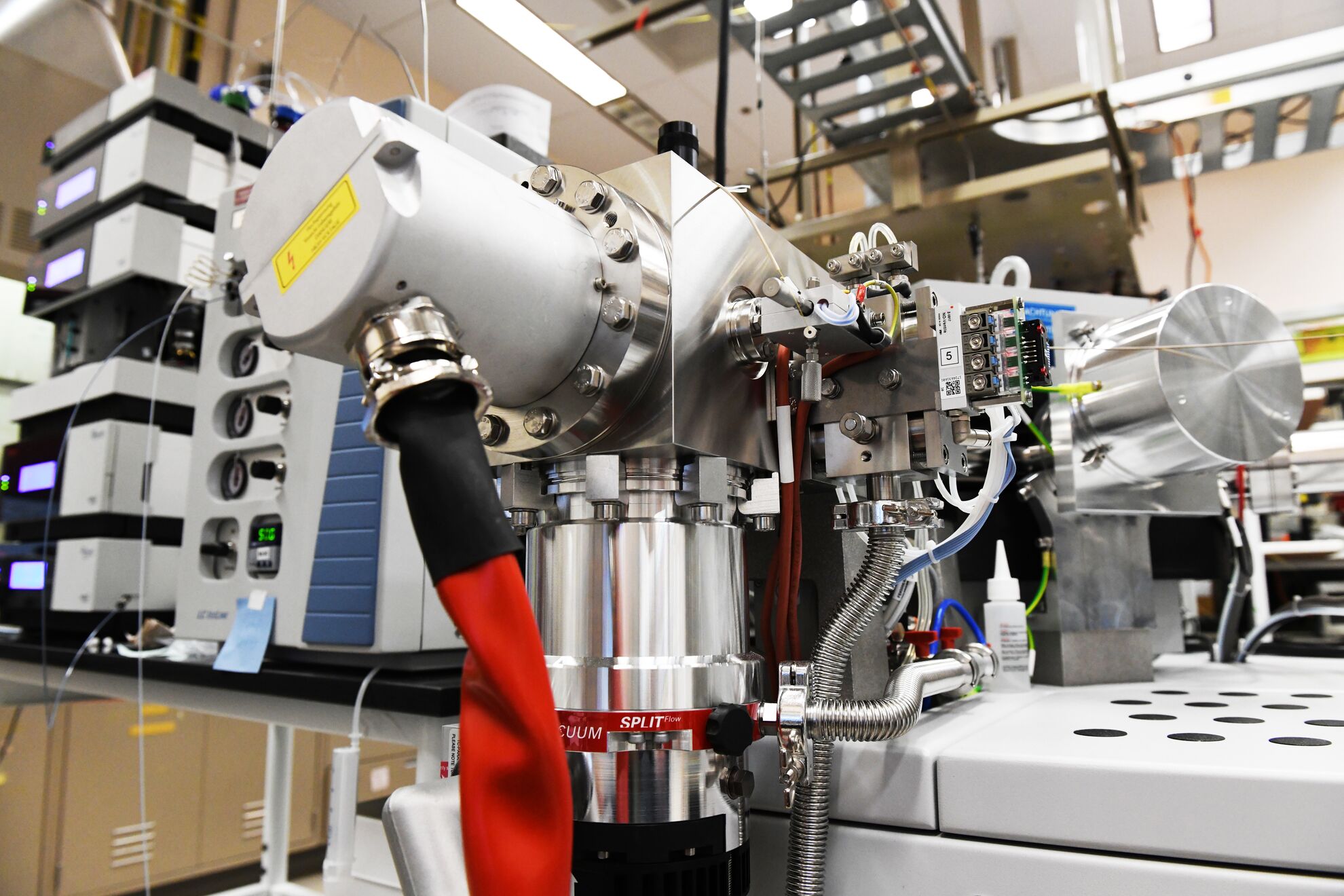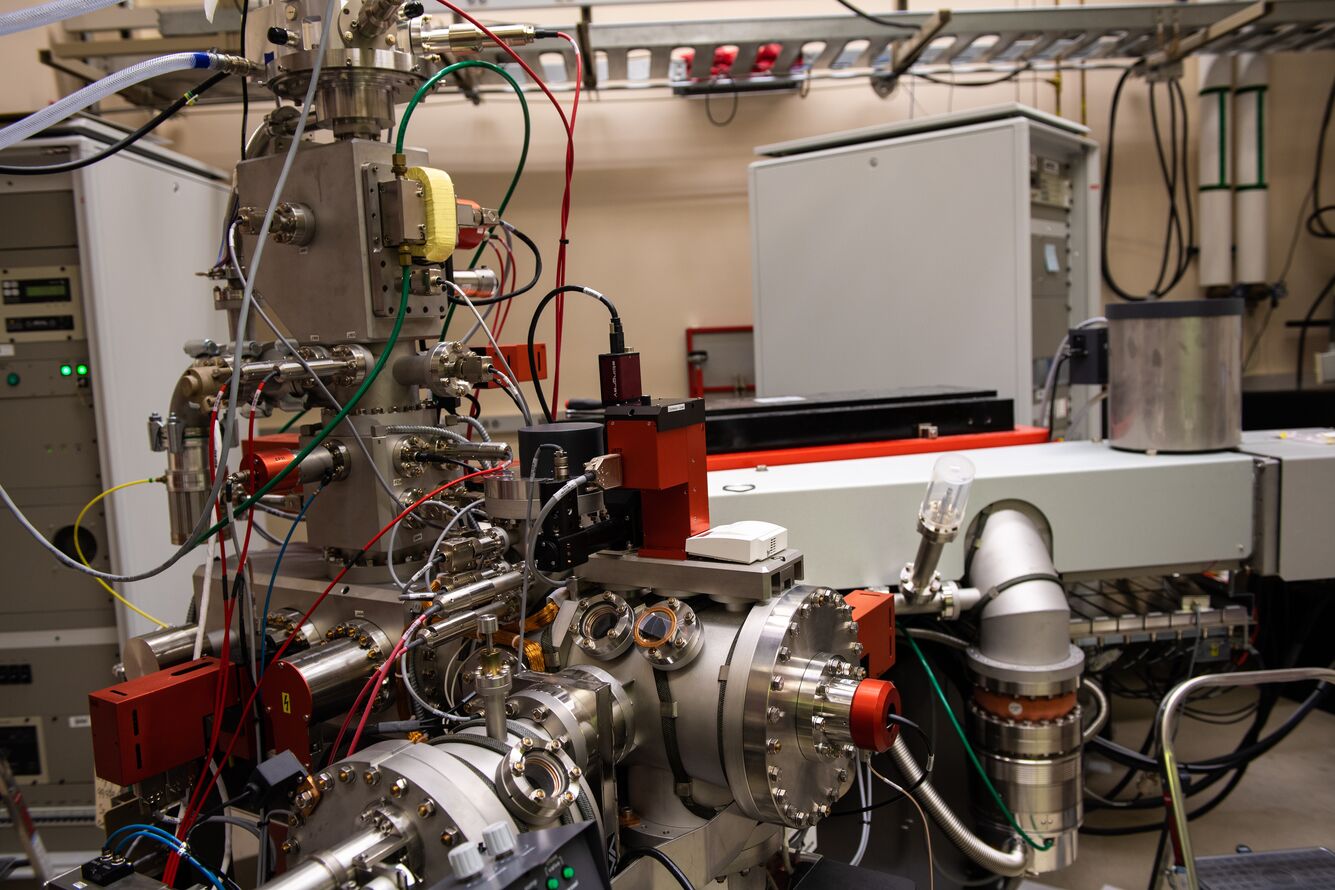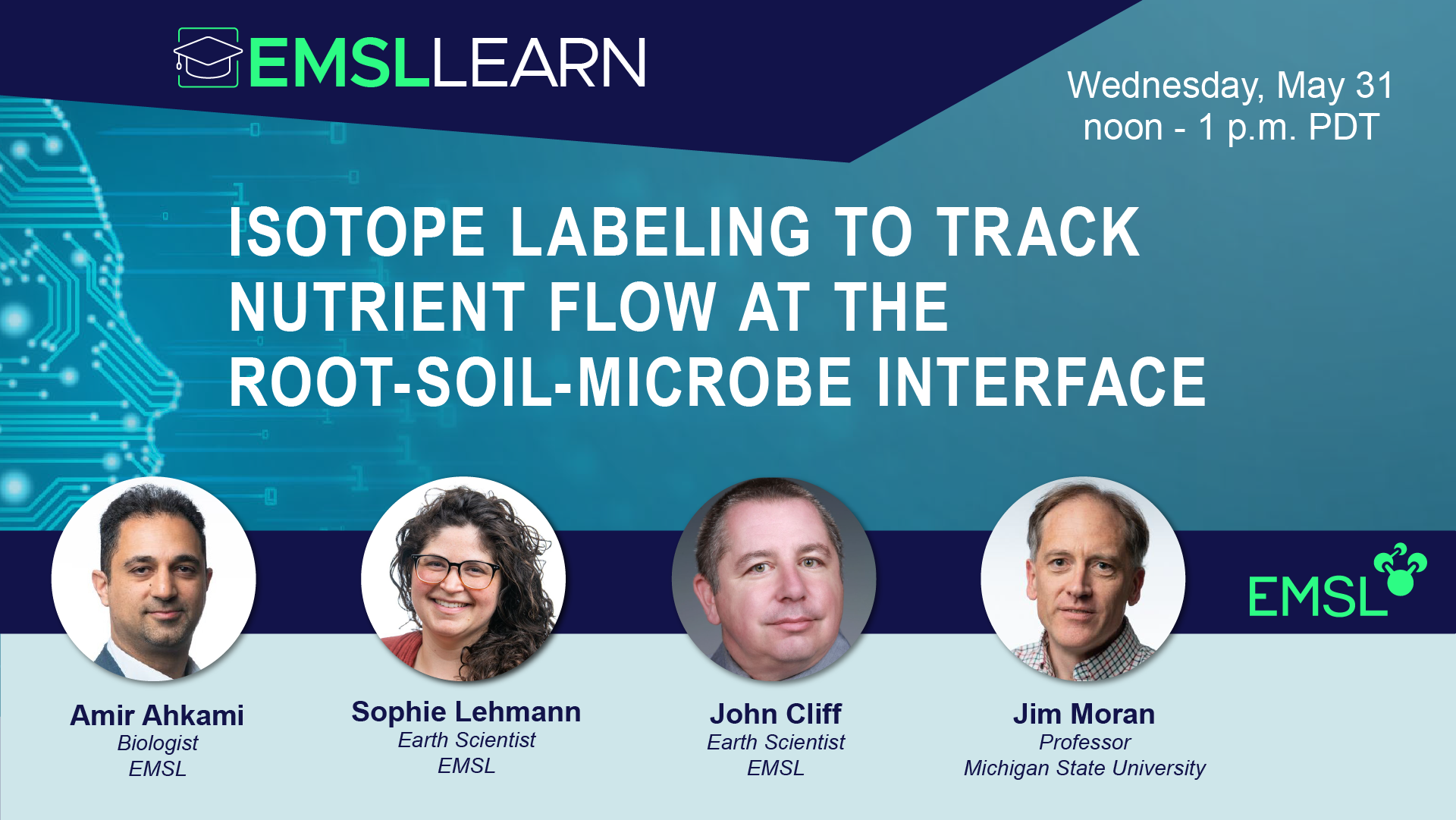Environmental Transformations and Interactions
Stable Isotope Analysis for Rhizosphere Research
Specialized EMSL mass spectrometers offer tools for studying root–soil–microbe interactions

Stable isotope tracing is an effective means of understanding the complexities of the rhizosphere. (Illustration provided by Adobe)
Dig into the soil associated with a plant and you’ll uncover a complex interface surrounding the roots known as the rhizosphere.
This region is a playground for biological activity, in which plant roots secrete nutrients to support diverse microbial communities including bacteria, fungi, algae, and viruses. The rhizosphere represents an epicenter of vital biogeochemical processes linked to plant health and soil carbon transformation.
Unraveling the biogeochemical interactions in the rhizosphere is challenging because of the inherent complexity of these interactions as well as the relatively small scale of the rhizosphere, which is often limited to just a few millimeters in width. Additionally, there are hotspots and hot moments within the rhizosphere that don’t have different levels of activity but produce accelerated process rates at either spatial or temporal scales.
“Stable isotope analysis is used in so many different fields—from past and current environment, to forensics, to medical sciences,” said Sophie Lehmann, an Earth scientist at Pacific Northwest National Laboratory. “There is a lot of information out there that cannot be seen, and stable isotope ratios are a way to observe changes in plants, animals, and environments.”
Stable isotope tracing is among a host of capabilities available at the Department of Energy’s Environmental Molecular Sciences Laboratory (EMSL), a user facility sponsored by the Biological and Environmental Research program. This capability in stable isotope analysis helps address key questions in rhizosphere dynamics. When a stable isotope tracer is added to the rhizosphere, it enters the active biogeochemical processes.
Advanced mass spectrometry capabilities at EMSL can then quantify the chemical, spatial, or temporal disposition of the tracer to enlighten understanding of specific reactions occurring and the associated controls on these processes.
Two EMSL capabilities—the isotope ratio mass spectrometer (IRMS) and the nanoscale secondary ion mass spectrometer (NanoSIMS)—are used for stable isotope studies of the rhizosphere. This instrumentation will be showcased during a free EMSL LEARN webinar, “Isotope labeling to track nutrient flow at the root–soil–microbe interface at noon Pacific daylight time on Wednesday, May 31. User research related to the rhizosphere and environmental science is supported by EMSL’s Rhizosphere Function Integrated Research Platform.
Isotope ratio mass spectrometry (IRMS)
IRMS provides ultra-precise analysis of stable isotopes, helping researchers understand the effects of different microbial interactions or environmental conditions on overall biogeochemical processes. By using IRMS at EMSL, scientists can track the flow of carbon through the rhizosphere and help assess the impact of active biogeochemical processes on soil carbon cycling.

IRMS quantifies the reactivity and progression of an applied stable isotope tracer, which helps determine reaction rates and final disposition of applied substrates. By measuring the stable isotope content of samples, researchers gain valuable insights for environmental and microbial studies.
IRMS uses magnetic sector mass spectrometry to measure the stable isotope content of a sample with high precision. Measurements focus on hydrogen, carbon, nitrogen, and oxygen analyses. Solid, liquid, or gas phase samples are converted into simple gases and then introduced to the IRMS. These simple gases are ionized and then accelerated down a flight tube, separated by mass, and the associated isotope distribution is quantified.
“We are looking at isotopes of some of the most common elements on Earth and which are building blocks of molecules critical to biogeochemical cycling,” Lehmann said, who oversees EMSL’s IRMS instrumentation. “We can use it to understand carbon drawdown from the atmosphere and carbon storage in minerals and in biological systems.””
Researchers can use stable isotope evaluation at EMSL to quantify critical interactions, which can be fed into different models to help predict future climate interactions.
Although IRMS capabilities can be found at other academic institutions or national laboratories, EMSL is home to four different IRMS systems and has a series of peripheral instrumentation all housed under one roof. The suite of additional capabilities at EMSL enables complementary analyses at levels not found at typical universities or user facilities.
At EMSL, researchers can analyze both organic and inorganic samples. Scientists can analyze isotope datasets at different spatial scales (cm to 10s µm) and in situ, which can be useful for evaluating nutrient flux through environments, Lehmann said.
James Moran, a joint appointee with EMSL and associate professor in the Departments of Integrative Biology and Plant, Soil, and Microbial Sciences at Michigan State University, uses IRMS, particularly laser ablation-IRMS (LA-IRMS), for performing spatially resolved stable isotope analysis through the root–rhizosphere–soil system. The combination of LA-IRMS with some of the other capabilities at EMSL can provide a unique analytical platform for examining processes in the rhizosphere.
“IRMS provides a fantastic method for quantifying nutrient exchanges and transformations in the environment,” Moran said.
Scientists can use stable isotopes to track conversion between compounds (for instance, carbon dioxide converted to organic root exudates), he said, or, when coupled to laser ablation, quantify the spatial distribution of these compounds.
LA-IRMS will be available through EMSL’s Exploratory Call for proposals, which opens in June 2023 for letters of intent submissions.
Nanoscale secondary ion mass spectrometry (NanoSIMS)

EMSL’s NanoSIMS is one of 50 such instruments available in the world, and EMSL is the only user facility within the Department of Energy that has this instrumentation, according to John Cliff, an analytical chemist who oversees EMSL’s NanoSIMS. At EMSL, the NanoSIMS team has academic training in biology and biogeochemistry and decades of combined SIMS experience.
“Isotopes can be used to track atoms and molecules through chemical, biological, and physical changes,” Cliff said. “I argue that many, perhaps most, environmental-chemical processes are controlled at sub-millimeter spatial scales. Because NanoSIMS interrogates these systems with sub-micron spatial resolution, it can be used to explore the mechanisms that control many environmental processes.”
NanoSIMS can be used to image elements/isotopes of inorganic and organic surfaces in environmental samples, subcellular structures, minerals, and atmospheric aerosols at the sub-micron scale.
As a new-generation ion microprobe, NanoSIMS extends secondary ion mass spectrometry analyses to spatial resolutions below 100 nanometers and maintains high sensitivity at high mass resolution. NanoSIMS can measure up to seven secondary ions in parallel, providing high-quality isotopic ratio imaging from the same small volume, all while maintaining perfect image superimposition of different isotopes.
Users will be able to submit letters of intent to the upcoming Exploratory Call to access NanoSIMS.
For examples of how IRMS and NanoSIMS have been used in soil–root–microbe interactions, review published research using EMSL’s instrumentation:
- Spatially tracking carbon through the root–rhizosphere–soil system using laser ablation-IRMS
- Spatially tracking 13C-labelled substrate (bicarbonate) accumulation in microbial communities using laser ablation isotope ratio mass spectrometry
- Forfeiting the priority effect: turnover defines biofilm community succession


